The concept of the vampire has undergone significant transformations since its introduction to popular folklore. From monstrous creatures lurking in the shadows to suave, seductive beings, the portrayal of these nocturnal entities has been deeply influenced by cultural and societal shifts. One intriguing aspect of this evolution is the sexualization of the vampire figure.
Historically, vampire myths from various cultures primarily centered around themes of fear, death, and the unknown. However, as these myths converged and transformed, particularly in European literature, vampires began to take on more human-like qualities. By the time the 19th century rolled around, the vampire image began its transition from purely terrifying to strangely alluring.
It was during the Victorian era, with its repressed sexuality and strict social norms, that the lines between horror and desire began to blur. Literature of this period often used supernatural elements as metaphors for societal fears and desires. The Victorian era’s fascination with death, combined with its strict moral codes, created a backdrop where forbidden desires and the allure of the unknown thrived.

One of the pivotal works from this era that encapsulated this shift is Bram Stoker's "Dracula". The Count, though monstrous, is undeniably charismatic and exudes a magnetic charm, especially towards women. This novel, with its gothic undertones and depictions of the Count's seductions, intertwines fear with fascination. The women in the story, often dressed in victorian dresses, symbolize the period's ideals of purity and innocence, making Dracula's allure all the more forbidden and intoxicating.
The sexual undertones in "Dracula" set a precedent for subsequent interpretations of vampire mythology. The 20th and 21st centuries witnessed a proliferation of vampire-themed media that continued to play on themes of forbidden desire. Whether it's Anne Rice's "The Vampire Chronicles", the "Twilight" series, or the "True Blood" television show, the seductive vampire trope has become deeply ingrained in popular culture.
So, while the sexualization of vampires might seem like a modern phenomenon, its roots trace back to centuries-old societal norms and literary traditions. The Victorian era, with its juxtaposition of repression and fascination with the macabre, played a crucial role in shaping the alluring and captivating image of the vampire we recognize today.
